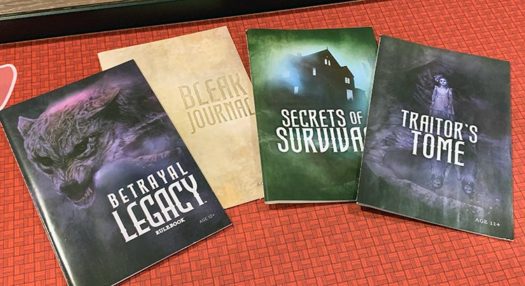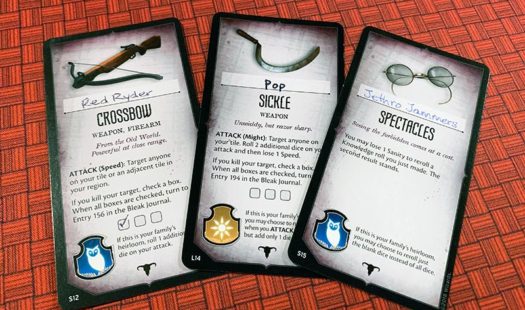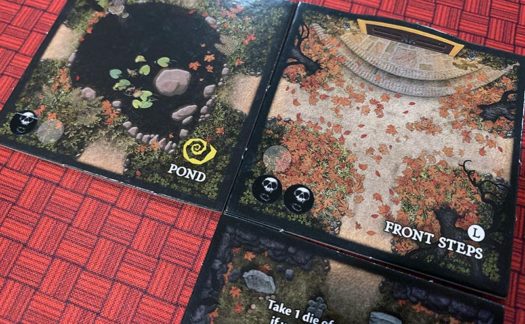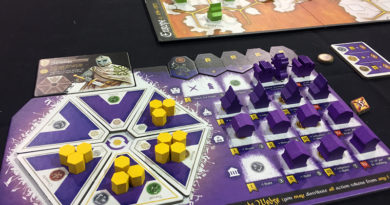Betrayal Legacy for your teens

When our oldest two boys were in high school, one of them came home one night telling us about the funnest game he had played at his friends house. It was called Betrayal at House on the Hill and they had a blast playing it.
I had heard about the game before but hadn’t paid attention to it until that day.
About a year later, while he was on his mission, I got a copy of Betrayal at House on the Hill in the game swap at SaltCon and looked forward to playing it with him when he returned.
But that didn’t stop us from giving it a try while he was gone either. And it was a hit!
When he returned, we took a family getaway trip and all the kids wanted to bring Betrayal at House on the Hill with us on the trip so we could all play it together — since it plays up to 6 people. We had a great time!
Then in 2018, Avalon Hill published a new version of the game called Betrayal Legacy.
It’s a “legacy” version of the game that sounded awesome. So last year we got it for Christmas and have had a ton of fun playing it!

How to play Betrayal Legacy
Betrayal Legacy is called “Legacy” because the nature of the game follows a new style of board games that morph as you play them. During play, players make permanent changes to the game that impact later plays of the game.
That way, by the time you’ve played through the whole series of initial games, your copy of the game is completely different from anyone else’s copy of the game. From there on out, you can continue playing the game as normal with all the changes your group has made it become.
The main game play of Betrayal Legacy is the same as Betrayal at House on the Hill. It’s a semi-cooperative game with two essential phases. Players all begin by exploring a haunted mansion together and then something bad happens that changes things up and typically one player turns Traitor and then it’s a one vs. many game to conclude.

Phase 1: Explore the Mansion
In Betrayal Legacy, there’s a “Legacy” deck of cards that players will reveal one at a time, read, and do what they say. Typically, after reading a few cards and maybe adding new elements to the game, players will come to a Pause or Stop in the deck after which, they then dive into taking turns and playing out the game.
Each player is a character with 4 traits of Speed, Might, Sanity, and Knowledge. On their turn, a player can move up to their Speed from tile to tile. If they choose to move through a doorway that is unexplored, they draw a new tile to place there.

The mansion has a Ground floor, Upper floor, and Basement. And in Betrayal Legacy, there is also now an Outside area. The back of each tile says what area it can be on. So if the player is in the Basement, they must keep bypassing new tiles until they get to one that says Basement on it.
Once revealed, they place the tile as the new room they just explored. If the tile has a symbol in the corner, the player draws the card from the associated deck (Event, Item, or Omen) and their movement for that turn ends.

As the names of the decks imply, players will uncover different types of things with each card. One difference from the original game is that the Event and Item cards are now also tied to specific areas of the haunted mansion. For example, some Items can only be found on the Upper floor.
When a player draws an Omen card, after doing what the card says, they’ll also then make a “Haunt” roll. The player that drew the card rolls dice equal to the number of discovered Omen cards to see if the Haunt is triggered. The Pause card in the Legacy deck will tell players what result will cause the Haunt to begin.
Phase 2: The Haunt
Most of the time a Haunt has two teams: Heroes and Traitor. When a Haunt begins, players will be instructed as to who is on which side as well as which Haunt is to be played.
The Traitor takes the Traitor’s Tome booklet into an another room while the Heroes read from the Secrets of Survival booklet. Each side reads the entry for the specific Haunt they’re playing and discovers their objectives and how they win or lose.
Once they understand what they’re now facing and how they want to approach it, both teams return to play through the rest of the game.
Players continue taking turns with the Traitor typically taking the last turn of each round.

As the Haunt may occur at any time, there still may be many rooms of the mansion unexplored. While facing off against each other, players may still enter unexplored rooms and continue adding tiles to the mansion. This is typically helpful to gain more Items to use in the battles underway.
It’s during the Haunt where most damage to the characters occurs. There will be Attacks and challenges throughout the game and the tiles, cards, or actions will indicate which of their 4 Traits the player must use.
The dice in the game show either 0, 1, or 2 dots. When a player rolls, they total all the dots rolled to get their result.

Failing will cause the player to drop in Physical (Speed/Might) or Mental (Sanity/Knowledge) traits. If a player hits the bottom mark in any trait (the skull), they die and are out of the game.
Players continue taking turns until one team meets the indicated win conditions to end the game.
At the end of each game, players then continue reading from the Legacy deck to discover what happens next.

Why we enjoy playing Betrayal Legacy
This is where we typically write about if a game can be enjoyed by the whole family. You may be able to tell already that Betrayal Legacy will not appeal to everyone in the family. For starters, based on the theme alone, this is a game best suited for teens and adults.
As the game theme covers haunted mansions, haunts, death, and cultist-like topics, that may rule it out for your family straight up. In fact, that’s why I hadn’t looked into the game years ago when I first heard about it. We’re also not a family that enjoys watching scary or creepy movies.
However, when we’re playing games, we’re often transported to playing roles that we wouldn’t touch in life.

For example, we won’t go around stealing, but have a great time playing as pirates sacking villages and looting ships. We won’t go around hurting other people, but “attack” each other in games all the time. And we enjoy many games that have monsters, magic, and mystical themes without crossing that over into real life. We enjoy the pretending arena that games offer.
As such, we approach Betrayal Legacy the same way. The game is full of extremely odd and bizarre elements that are so far-fetched that we see them as comical.
That begin said however, we want to be clear that you may steer otherwise for your family. So to give you a sense of the topics in the game, here are a few of the names of 36 possible Haunts to encounter in the game:
- Ghost in the Machine
- Her Beating Heart
- Slay Bells Ring
- The Doll’s Puppet
- Abductions
- The Demon of Ice and Winter

Now, on to what we enjoy about Betrayal Legacy.
The first 3 things are elements we enjoy about both versions of the game. The rest are specific to Betrayal Legacy.
Cooperative, Not Cooperative
We love all sorts of cooperative games. And as our kids have grown, we’ve enjoyed more and more those games that are either semi-cooperative or have a potential traitor/betrayer in the midst. And with Betrayal at House on the Hill and Betrayal Legacy, there will be a traitor of some sort.
And in our gang, most are chopping at the bit to have the luck of the Haunt fall on them to be the Traitor. I say most because our daughter doesn’t like that pressure. She prefers to be on the Heroes side every time.

Exploring the Mansion
It may sound simple, but one of the things we really enjoy in the game is exploring the mansion and “discovering” new rooms. Sure we see most of the same rooms from game to game. But they end up in different places every time. Thus, the way we can navigate the house changes every game. And that makes a difference when the Haunt occurs and you start chasing or being chased.

The Haunts
There must be some really creative people at Avalon Hill to come up with such bizarre Haunt scenarios. Whether it be cats chasing you around, dolls coming to life, things being sucked into a void, meteorites appearing, or nesting grounds needing destroyed, there’s a lot that can happen in this mansion.
Which Haunt occurs depends on which Omen card is encountered in which room.
And even though we’ve played both games a number of times, there’s still so much we have yet to encounter. Every game is definitely unique.

Ancestors, Descendants, and Family Stories
The biggest draw for us in diving into Betrayal Legacy has been the storyline that continues from game to game.
At the outset, each player takes a Family Board and makes up a family name to write on it. Thereafter, every game will have someone from that family participate in the adventure.

On the backside of the board, players will write the first name of a member of the family and their age on the first line. At the end of each game, the player will write what happened to that family member and if they lived or died and if they were the traitor.
In each subsequent game, the player who controls that family can either continue with that same family member (if they lived) or make up a new family member and age.
We’ve had a blast reliving past games each time we start a new game because we see again what we’ve written about our past characters. We spend a few minutes before each new play laughing about what happened last time because we have a written record of it.
So fun.

Family Heirlooms
Another cool aspect in Betrayal Legacy related to a family line is that when a player draws an Item from the deck during a game, they may be able to make it a family heirloom!
Each family has 9 Heirloom stickers, allowing them to heirloom up to 9 Items over the course of the campaign. Once per game, when a player draws an Item card that has a space for an heirloom sticker, the player may choose to make it a family heirloom.
They place one of their stickers on the card and name the Item.
In future games, if that player gets that Item again, they’ll get additional powers from it because it’s one of their family heirlooms!

Adding Tiles, Stickers, Rules, and Names
Over the course of the 13 chapters in the initial campaign, players will constantly be adding things to the game.
At the outset, there are only a few tiles players will be able to explore near the mansion. As the players progress, new areas and mansion tiles will be added to the game. And new sections will be added to the rulebook through stickers yet unseen.
Likewise, more cards will continuously be added to the Event, Item, and Omen decks as players trigger different things during game play.
There’s also a huge sheet of stickers that include family crest, heirloom, and other items that will be placed on cards and tiles along the way. Each of these stickers will have an impact in the game and during future games.

In addition to their family members on the back of their family board, players will also get to name different elements of the game — such as Items they find.
We love this aspect of the game because it means that our copy of the game is unique to us. And the stories will live on for a long time.
We can even imagine future grandkids playing the game and learning the stories of our original time playing the game. Not only because they’re now written on the cards and boards themselves, but because they’ll want to know why things are labeled that way and we’ll tell them. Thus, our experiences will truly live on in the collective memory of future plays.

The Story of the House
In addition to each player writing down the fate of their family member on the back of their family board after each game, players will record the History of the House!
There are 3 pages at the back of the Traitor’s Tome where players can craft a story of the house by what happened during the game. Players can be as creative or descriptive as they want.
As our kids love to tell stories, this is a great way to note things that will jog our memory of how things played out.
We just wish there were more pages so we could really get creative.

Random Roles
Betrayal Legacy also adds in a new element called “Callings” to the game. Players discover these within the first couple of chapters and more are added over the course of the initial 13 chapters as well. At the start of each game, in addition to writing their family member to the back of their board, players will draw a random Calling card.
The Callings give each player special abilities during that game. While not earth-shattering, these special abilities are a nice addition that players can use in working together.
We had a great laugh in the game when a 9-year old character had the “War Veteran” calling. It’s twists like that that add a lot of fun to the game.

Continuous Free Play
While we have yet to complete all 13 chapters in the initial campaign, one thing we’re happy about is that even after those initial 13 games, we’ll still be able to play Betrayal Legacy in Free Play mode.
Since there are 36 possible Haunts, we’re only going to have scratched the surface of what’s possible after 13 games. There’s still going to be plenty of fun to go!
The only thing that really changes is that after 13 games, you’ll stop adding new things to the game.
There will be many cards players never get to encounter. Because of how each unique initial 13 games go, there may be cards that are never added to the decks. But there will still be plenty that will have been added.
While we won’t be adding any more stickers or writing on cards, we will have plenty of Haunts to encounter and fun times to have!

Only 5 Players
The one big downside we’ve encountered, is that Betrayal Legacy only allows up to 5 players to play. With our family of 6, we were very disappointed to discover that.
Although, we quickly overcame that issue because mom isn’t very keen to play Betrayal anyway. Yes, she did humor us and play the original Betrayal at House on the Hill with the whole gang. But it’s definitely not a type of game she enjoys.
So mom is fine with sitting out the campaign aspect of Betrayal Legacy.
While you don’t have to play with 5 people, it sure is fun having a full player count. And you also aren’t limited to playing with the same 5 people every time. You can switch out players.
However, because of the continuing family storyline aspect of the game, we’ve all agreed to play with our same 5 players every time. Which unfortunately has been trickier now that we have kids off to college and only our youngest still at home.
How does Betrayal Legacy score on our “Let’s Play Again” game meter?
 Do you really need to ask?
Do you really need to ask?
We got Betrayal Legacy last Christmas and played it a few times while school was out over Christmas break. But since then we’ve had to schedule specific days to play when everyone would be home together. So far we’re halfway though the initial chapters and greatly anticipate the next time we’ll be able to play together again (like again during the upcoming holiday breaks).
Other than the first 2 chapters, we haven’t played any games back-to-back. The first couple of chapters don’t last as long because there isn’t too much of the mansion available to discover yet. But the game builds from there and typically last 60 to 90 minutes.
And that’s another reason we now need to schedule out when we’re going to play.
But there’s no doubt we’ll be playing Betrayal Legacy again and again for years to come.
We’d like to thank Miniature Market for a review copy of Betrayal Legacy.






I’ve been super intrigued by this since it was first announced. The only thing that’s kept me from picking it up is the logistics of continuing the game with family members. Like you, it’s been trickier as the kids have gotten older. Right now we have a very brief moment where all 3 are home again but that changes in 2 weeks when my middle son leaves and then again in 4 months when my oldest son gets married.
I’m hoping we’ll be able to finish out our current 2 in-progress Legacy games but I think I may have to evaluate other group options if I want to start a new one in the near future.
Chris – I can totally understand where you’re coming from on family members leaving the nest making this tough. Stick with getting through your current legacy games and this just gives you something to look forward to when your middle son gets back down the road. It may not be the near future, but it’s fun to thing of games down the road as well. That’s actually why I bought a copy of Stuffed Fables – not because I want to play with my kids now, but to play with grandkids in future years to come.